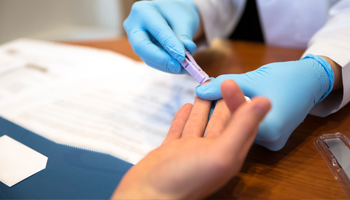HOW CAN WE HELP YOU? Call 1-800-TRY-CHOP
In This Section
How Do Patient and Healthcare Factors Affect the Prevalence of HIV Testing in Adolescents?

By Kate Knab
The findings:
Through a retrospective study of sexually transmitted infection (STI) episodes of adolescents between 13 and 24 years old, researchers from CHOP’s PolicyLab discovered suboptimal HIV testing rates, especially for those at the highest risk of HIV infection. Of the 1,816 STI episodes, only 55 percent had a completed HIV test. Females, participants with previous STIs, participants without insurance, and those with confidential sexual health encounters were associated with a decrease in rates of HIV testing. Researchers also identified that STI diagnosis during a family planning visit resulted in lower odds of HIV screening than diagnosis from a primary care physician.
Why it matters:
Adolescents and young adults have the highest transmission rate among people living with HIV, and the percentage has been growing since 2013. This study demonstrates the need for rapid HIV testing and for educating healthcare providers on the importance of screening at the time of STI infection diagnosis. By identifying missed opportunities for testing, researchers have opened up new paths to treatment and, most importantly, to prevention of the disease.
Who conducted the study:
The study team included Danielle Petsis, MPH, clinical research coordinator at PolicyLab and the Craig-Dalsimer Division of Adolescent Medicine at CHOP; Jungwon Min, PhD, MS, statistical scientist in the Healthcare Analytics Unit (HAU) at PolicyLab and Clinical Futures; Yuan-Shung Huang, MS, manager of the HAU at PolicyLab and Clinical Futures; Aletha Y. Akers, MD, MPH, FACOG, medical director of Adolescent Gynecology Consultative Services in the Craig-Dalsimer Division of Adolescent Medicine; and Sarah Wood, MD, MSHP, professor of Pediatrics at the University of Pennsylvania Perelman School of Medicine and attending physician in the Craig-Dalsimer Division of Adolescent Medicine at CHOP.
How they did it:
The study team conducted a retrospective study using electronic health record (EHR) data from two urban pediatric/adolescent primary care clinics in Philadelphia. During a limited observation period, adjusted for the unavailability of rapid HIV tests at both sites, HIV screening was performed by laboratory-based, fourth-generation antigen-antibody testing. Then, researchers conceptualized the data from the EHR through a commercial business intelligence platform to create a final analytic data set containing all visits with an incident of STI episode and all follow-up visits within 90 days of the episode. They determined the prevalence of HIV testing and evaluated factors associated with HIV testing in these patients.
Quick thoughts:
“It is our hope that our findings can be used to target HIV testing interventions in primary care settings,” the study authors wrote.
What’s next:
This study indicates a need for better HIV testing education across all levels of public healthcare, including information on when to test and why. “With our sights set on reducing new HIV diagnoses, how and where can we improve testing rates and establish more consistent comprehensive prevention for these youth in our community?” Petsis wrote in a PolicyLab blog post.
The study team is exploring how EHR-based clinical decision support tools for providers could remind primary care physicians when to test for HIV and create an easy-to-use interface for ordering HIV tests.
Where the study was published:
This study appeared in Pediatrics.
Where to learn more:
Find out more about the research of Petsis and her team in her PolicyLab blog post.


